жӮЁеҘҪпјҢзҷ»еҪ•еҗҺжүҚиғҪдёӢи®ўеҚ•е“ҰпјҒ
жң¬зҜҮеҶ…е®№дё»иҰҒи®Іи§ЈвҖңжҖҺд№ҲдҪҝз”Ёcgdb + qemuи°ғиҜ•linuxеҶ…ж ёжЁЎеқ—вҖқпјҢж„ҹе…ҙи¶Јзҡ„жңӢеҸӢдёҚеҰЁжқҘзңӢзңӢгҖӮжң¬ж–Үд»Ӣз»Қзҡ„ж–№жі•ж“ҚдҪңз®ҖеҚ•еҝ«жҚ·пјҢе®һз”ЁжҖ§ејәгҖӮдёӢйқўе°ұи®©е°Ҹзј–жқҘеёҰеӨ§е®¶еӯҰд№ вҖңжҖҺд№ҲдҪҝз”Ёcgdb + qemuи°ғиҜ•linuxеҶ…ж ёжЁЎеқ—вҖқеҗ§!
Linux д»Јз ҒеәһеӨ§иҖҢз№ҒжқӮпјҢе…үзңӢд»Јз ҒдјҡдҪҝдәәеӨҙжҷ•зӣ®зң©пјҢеҰӮжһңиғҪйҖҡиҝҮи°ғиҜ•е·Ҙе…·еҜ№е…¶д»Јз Ғжү§иЎҢжөҒзЁӢиҝӣиЎҢи°ғиҜ•пјҢеҲҷеҜ№еӯҰд№ Linux kernelд»ҘеҸҠи§ЈеҶіе№іж—¶йҒҮеҲ°зҡ„й—®йўҳдјҡеӨ§жңүеё®еҠ©гҖӮжң¬ж–Үе°Ҷи®Іи§ЈеҰӮдҪ•дҪҝз”Ёcgdb + qemuзҡ„ж–№ејҸи°ғиҜ•LinuxеҶ…ж ёд»Јз ҒпјҢжүҖдҪҝз”Ёзҡ„жөӢиҜ•жңәж“ҚдҪңзі»з»ҹзүҲжң¬жҳҜCentOS Linux release 7.2.1511 (Core)
еҶ…ж ёд»Јз ҒдёӢиҪҪең°еқҖпјҡ[
https://www.kernel.org/] (
https://www.kernel.org/)пјҢжң¬ж–Үд»Ҙ4.9.153зүҲжң¬дҪңдёәжј”зӨә. еҰӮдёӢеӣҫпјҢзӮ№еҮ»еҜ№еә”зүҲжң¬зҡ„ tarball й“ҫжҺҘдёӢиҪҪ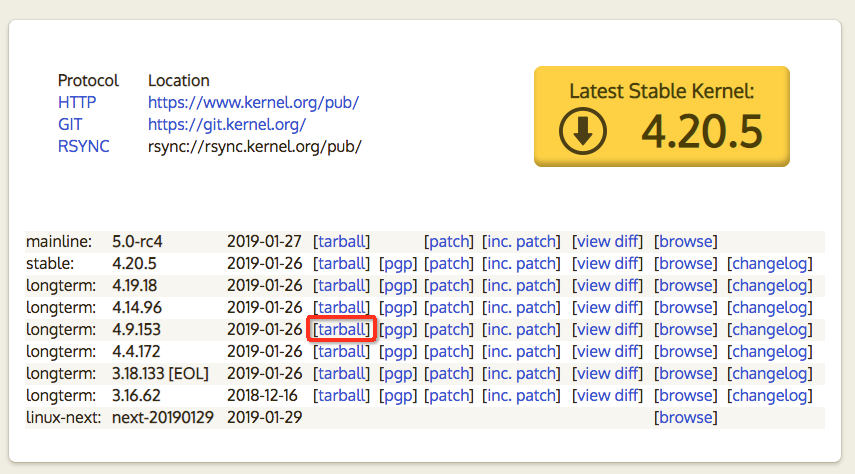
дёӢиҪҪе®ҢжҲҗеҗҺе°Ҷtarж–Ү件жӢ·иҙқеҲ°жөӢиҜ•жңә/rootзӣ®еҪ•е№¶иҝӣиЎҢи§ЈеҺӢгҖӮ
# cd /root # tar xf linux-4.9.153.tar.xz
# cd linux-4.9.153 # make menuconfig
е®ҡдҪҚеҲ°Enable loadable module support:
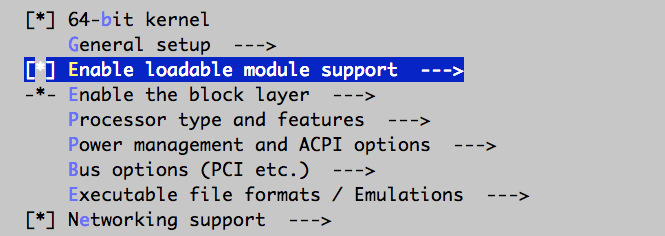
жҢүз©әж јй”®еҺ»жҺүйҖүйЎ№Module signature verificationпјҢйҳІжӯўеҠ иҪҪжЁЎеқ—ж—¶еҰӮдёӢжҠҘй”ҷпјҡmodule verification failed: signature and/or required key missing - tainting kernel
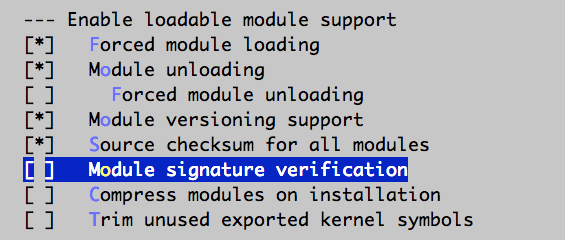
е®ҡдҪҚеҲ°ExitжҢүй’®пјҢеӣһеҲ°дёҠзә§иҸңеҚ•гҖӮ
е®ҡдҪҚеҲ°File systems, жҢүеӣһиҪҰй”®:
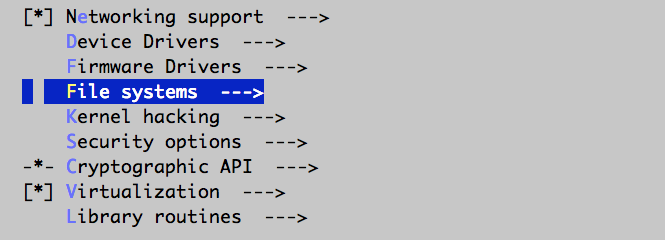
йҖүдёӯEXT4 debugging support е’Ң
JBD2 (ext4) debugging support дёӨйЎ№:
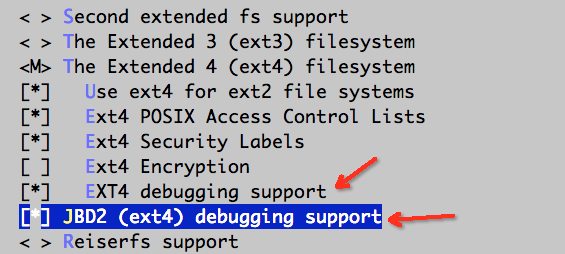
е®ҡдҪҚеҲ°ExitжҢүй’®пјҢеӣһеҲ°дёҠзә§иҸңеҚ•гҖӮ
е®ҡдҪҚеҲ°Kernel hackingпјҢжҢүеӣһиҪҰй”®:

е®ҡдҪҚеҲ°Kernel debuggingпјҢжҢүз©әж јй”®йҖүдёӯгҖӮ
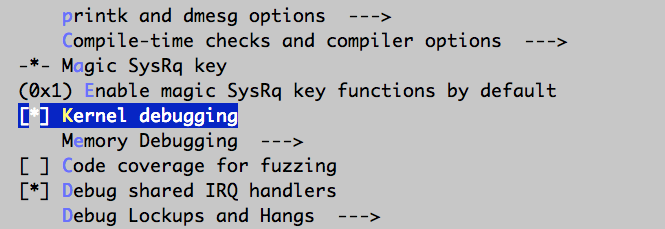
е®ҡдҪҚеҲ°Compile-time checks and compiler optionsпјҢ жҢүеӣһиҪҰй”®гҖӮ
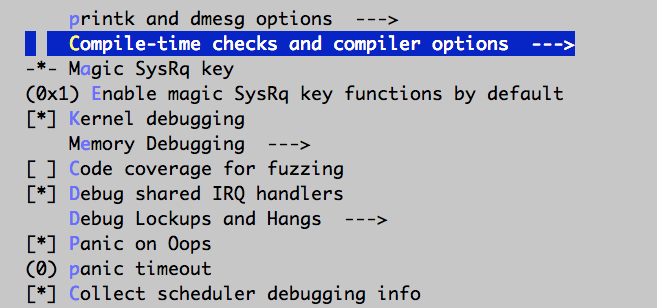
еҲҶеҲ«е®ҡдҪҚеҲ°
Compile the kernel with debug info е’Ң
Provide GDB scripts for kernel debugging , 并жҢүз©әж јй”®йҖүдёӯгҖӮ
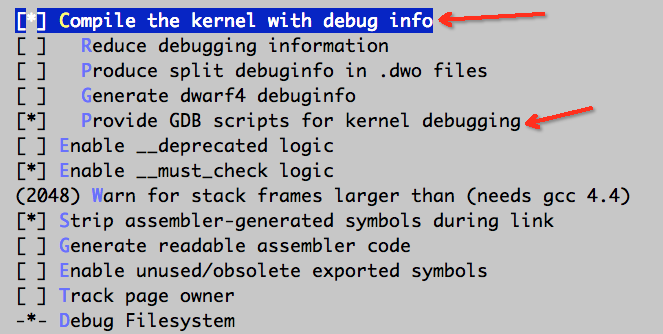
дҝқеӯҳпјҢйҖҖеҮә



make -j 30
-j 30 иЎЁзӨә并иЎҢзј–иҜ‘зҡ„CPUж ёж•°
иҝҷйҮҢеҖҹеҠ©Busyboxжһ„е»әжһҒз®ҖinitramfsжҸҗдҫӣеҹәжң¬зҡ„з”ЁжҲ·жҖҒеҸҜжү§иЎҢзЁӢеәҸ.
[дёӢиҪҪbusybox-1.28.0] ( https://busybox.net/downloads/busybox-1.28.0.tar.bz2)пјҢ并жӢ·иҙқеҲ°жөӢиҜ•жңә/rootзӣ®еҪ•дёӢи§ЈеҺӢгҖӮ
й…ҚзҪ®CONFIG_STATICеҸӮж•°пјҢеҸҜзј–иҜ‘еҮәйқҷжҖҒзүҲBusybox, дҪҝBusyboxзҡ„еҸҜжү§иЎҢж–Ү件дёҚдҫқиө–еҠЁжҖҒеә“пјҢж–№дҫҝжһ„е»әinitramfs
# cd /root/busybox-1.28.0 # make menuconfig
йҖүжӢ©Settings, жҢүеӣһиҪҰгҖӮ

йҖүжӢ©Build static binary (no shared libs), жҢүеӣһиҪҰгҖӮ

йҖҖеҮәпјҢжҸҗзӨәдҝқеӯҳпјҢйҖүYes
ејҖе§Ӣзј–иҜ‘
# yum install glibc-static -y # gcc --version gcc (GCC) 4.8.5 20150623 (Red Hat 4.8.5-4) # make -j 30 # make install
еҲӣе»әinitramfs, е…¶дёӯеҢ…еҗ«BusyBoxеҸҜжү§иЎҢзЁӢеәҸпјҢеҝ…иҰҒзҡ„и®ҫеӨҮж–Ү件пјҢеҗҜеҠЁи„ҡжң¬initе’ҢйңҖиҰҒи°ғиҜ•зҡ„жЁЎеқ—гҖӮеңЁinitи„ҡжң¬йҮҢеҸӘжҢӮиҪҪдәҶиҷҡжӢҹж–Ү件系з»ҹprocfsе’ҢsysfsпјҢжІЎжңүжҢӮиҪҪзЈҒзӣҳж №ж–Ү件系з»ҹпјҢжүҖжңүи°ғиҜ•ж“ҚдҪңйғҪеңЁеҶ…еӯҳдёӯиҝӣиЎҢпјҢдёҚдјҡиҜ»еҶҷзЈҒзӣҳгҖӮжң¬дҫӢдёӯдҪҝз”Ёext4.koжЁЎеқ—дҪңдёәжј”зӨәпјҢжүҖд»ҘйңҖиҰҒе°Ҷext4.koеҸҠе…¶дҫқиө–жЁЎеқ—дёҖиө·ж”ҫеҲ°initramfsгҖӮ
# mkdir initramfs
# cd initramfs
# cp ../_install/* -rf ./
# mkdir dev proc sys
# sudo cp -a /dev/{null, console, tty1, tty2, tty3, tty4} dev/
# rm linuxrc
# touch init
# chmod a+x init
# mkdir -p lib/modules/4.9.153/
# cp /root/linux-4.9.153/fs/ext4/ext4.ko lib/modules/4.9.153/
# cp /root/linux-4.9.153/fs/jbd2/jbd2.ko lib/modules/4.9.153/
# cp /root/linux-4.9.153/fs/mbcache.ko lib/modules/4.9.153/
# ls
bin dev init lib proc sbin sys usrinitж–Ү件зҡ„еҶ…е®№
#!/bin/busybox sh mount -t proc mone /proc mount -t sysfs none /sys mdev -s exec /sbin/init
жү“еҢ…initramfs:
# find . -print0 | cpio --null -ov --format=newc | gzip -9 > ../initramfs.cpio.gz
# yum install qemu-system-x86-2.0.0 # cd .. # pwd /root/busybox-1.28.0 # qemu-system-x86_64 -s -kernel /root/linux-4.9.153/arch/x86_64/boot/bzImage -initrd initramfs.cpio.gz -nographic -append "console=ttyS0" -m 1G
qemu-system-x86_64 е‘Ҫд»Өз”ЁеҲ°зҡ„еҸӮж•°иҜҙжҳҺпјҡ
-s жҳҜ
-gdb tcp::1234 зҡ„зј©еҶҷпјҢиЎЁзӨәзӣ‘еҗ¬1234з«ҜеҸЈпјҢеңЁgdbдёӯеҸҜд»ҘйҖҡиҝҮ
target remote localhost:1234 иҝһжҺҘпјӣ
-kernel жҢҮе®ҡзј–иҜ‘еҘҪзҡ„и°ғиҜ•зүҲеҶ…ж ёпјӣ
-initrd жҢҮе®ҡеҲ¶дҪңеҘҪзҡ„initramfsпјӣ
-nographic еҸ–ж¶ҲеӣҫеҪўиҫ“еҮәзӘ—еҸЈпјҢдҪҝQEMUжҲҗдёәз®ҖеҚ•зҡ„е‘Ҫд»ӨиЎҢзЁӢеәҸпјӣ
-append console=ttyS0 е°Ҷиҫ“еҮәйҮҚе®ҡеҗ‘еҲ°consoleпјҢе°ҶдјҡжҳҫзӨәеңЁж ҮеҮҶиҫ“еҮәдёӯstdio, жіЁпјҡиҝҷйҮҢttyS0дёӯзҡ„SеӨ§еҶҷ;
-m 1G и®ҫзҪ®иҷҡжӢҹжңәеҶ…еӯҳеӨ§е°ҸгҖӮ
еҗҜеҠЁе®ҢжҲҗеҗҺеҸҜжҢүеӣһиҪҰй”®иҝӣе…Ҙе‘Ҫд»ӨиЎҢдәӨдә’з•Ңйқў
... [ 1.645828] Freeing unused kernel memory: 836K [ 1.659842] Freeing unused kernel memory: 748K can't run '/etc/init.d/rcS': No such file or directory Please press Enter to activate this console. [ 2.144752] tsc: Refined TSC clocksource calibration: 2194.896 MHz [ 2.145315] clocksource: tsc: mask: 0xffffffffffffffff max_cycles: 0x1fa35d3c521, max_idle_ns: 440795261667 ns [ 2.377779] input: ImExPS/2 Generic Explorer Mouse as /devices/platform/i8042/serio1/input/input3 [ 3.153834] clocksource: Switched to clocksource tsc / # ls bin dev init proc root sbin sys usr / #
cgdb жҳҜgdbзҡ„дёҖдёӘеўһејәзүҲпјҢи°ғиҜ•зҡ„ж—¶еҖҷзңӢд»Јз ҒдјҡзҫҺи§Ӯи®ёеӨҡгҖӮжҲ‘们е°ҶеңЁеҸҰеӨ–зҡ„дёҖдёӘзӘ—еҸЈзҷ»еҪ•жөӢиҜ•жңәпјҢиҝҗиЎҢcgdbи°ғиҜ•еҶ…ж ёгҖӮ
# yum install cgdb -y # cgdb -v CGDB 0.6.8 # cd /root/linux-4.9.153 # cgdb vmlinux
еңЁgdbе‘Ҫд»ӨиЎҢйҮҢиҫ“е…Ҙtarget remote :1234иҝӣиЎҢиҝңзЁӢи°ғиҜ•пјҢеңЁеҮҪж•°register_filesystemйҮҢи®ҫзҪ®ж–ӯзӮ№еҗҺиҫ“е…ҘcеӣһиҪҰпјҢ然еҗҺеңЁиҷҡжӢҹжңәйҮҢиҝҗиЎҢе‘Ҫд»Өmodprobe ext4еҠ иҪҪext4ж–Ү件系з»ҹжЁЎеқ—еҚіеҸҜиҝӣе…ҘеҮҪж•°register_filesystemе‘Ҫдёӯж–ӯзӮ№гҖӮе‘Ҫдёӯж–ӯзӮ№еҗҺпјҢжҲ‘们жү“еҚ°fs->nameпјҢеҸ‘зҺ°жҳҜext3пјҢиҝҷжҳҜеӣ дёәеңЁext4зҡ„жЁЎеқ—еҲқе§ӢеҢ–еҮҪж•°ext4_init_fsйҮҢе…Ҳи°ғз”ЁдәҶregister_as_ext3();д№ӢеҗҺеҸҲи°ғз”ЁдәҶregister_as_ext2(); е’Ң
register_filesystem(&ext4_fs_type);
(gdb) target remote :1234 Remote debugging using :1234 native_safe_halt () at ./arch/x86/include/asm/irqflags.h:57 (gdb) b register_filesystem Breakpoint 1 at 0xffffffff81257dd0: file fs/filesystems.c, line 70. (gdb) c Continuing. Breakpoint 1, register_filesystem (fs=0xffffffffa00a0ac0) at fs/filesystems.c:70 (gdb) p fs->name $1 = 0xffffffffa0095cc0 "ext3" (gdb)
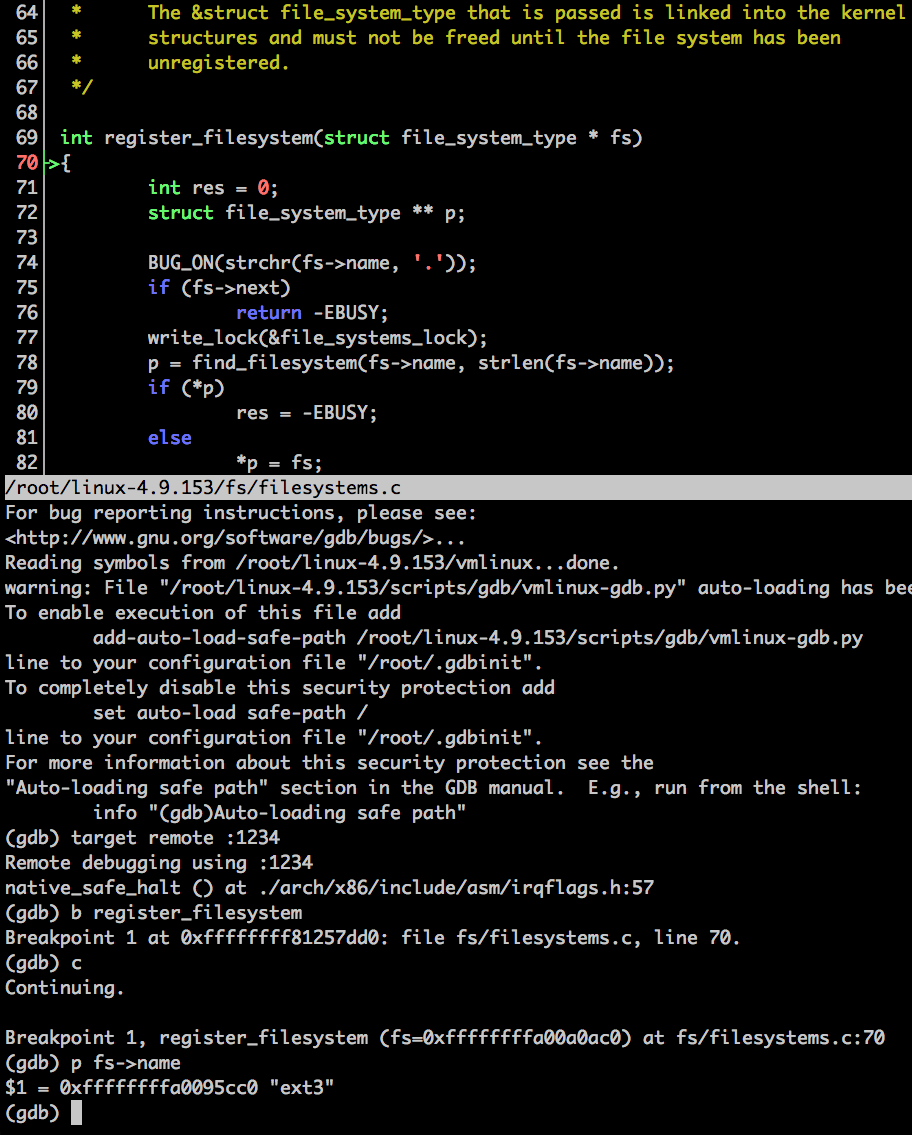
еҲ°жӯӨпјҢзӣёдҝЎеӨ§е®¶еҜ№вҖңжҖҺд№ҲдҪҝз”Ёcgdb + qemuи°ғиҜ•linuxеҶ…ж ёжЁЎеқ—вҖқжңүдәҶжӣҙж·ұзҡ„дәҶи§ЈпјҢдёҚеҰЁжқҘе®һйҷ…ж“ҚдҪңдёҖз•Әеҗ§пјҒиҝҷйҮҢжҳҜдәҝйҖҹдә‘зҪ‘з«ҷпјҢжӣҙеӨҡзӣёе…іеҶ…е®№еҸҜд»Ҙиҝӣе…Ҙзӣёе…ійў‘йҒ“иҝӣиЎҢжҹҘиҜўпјҢе…іжіЁжҲ‘们пјҢ继з»ӯеӯҰд№ пјҒ
е…ҚиҙЈеЈ°жҳҺпјҡжң¬з«ҷеҸ‘еёғзҡ„еҶ…е®№пјҲеӣҫзүҮгҖҒи§Ҷйў‘е’Ңж–Үеӯ—пјүд»ҘеҺҹеҲӣгҖҒиҪ¬иҪҪе’ҢеҲҶдә«дёәдё»пјҢж–Үз« и§ӮзӮ№дёҚд»ЈиЎЁжң¬зҪ‘з«ҷз«ӢеңәпјҢеҰӮжһңж¶үеҸҠдҫөжқғиҜ·иҒ”зі»з«ҷй•ҝйӮ®з®ұпјҡis@yisu.comиҝӣиЎҢдёҫжҠҘпјҢ并жҸҗдҫӣзӣёе…іиҜҒжҚ®пјҢдёҖз»ҸжҹҘе®һпјҢе°Ҷз«ӢеҲ»еҲ йҷӨж¶үе«ҢдҫөжқғеҶ…е®№гҖӮ
жӮЁеҘҪпјҢзҷ»еҪ•еҗҺжүҚиғҪдёӢи®ўеҚ•е“ҰпјҒ